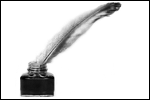
|
|
CHILDREN'S SCIENTIFIC LABORATORY
Telescope without a single glass. Children's Science Lab
Directory / Children's Science Lab The device of the telescope is now not seriously studied at school, and many would like to make it. So we decided to help you with this. But first, let's do a few experiments using a school kit for laboratory work in optics. Look through a magnifying glass at distant objects - nothing but hazy images. Now place a frosted screen behind the magnifying glass and you will see a distinct but inverted and greatly reduced image. Try looking at it through another magnifying glass (fig. 1) and then... remove the screen. By slightly adjusting the position of the second lens, you will get a good, sharp image. In principle, this is an optical device operating according to the scheme of a telescope. Its magnification is equal to the ratio of the focal length of the first lens (called the lens) to the focal length of the second (eyepiece). The focal length of the lens must be longer than that of the eyepiece. Only then will the telescope "bring closer" distant objects.
The fact that the image in the telescope is inverted does not create any inconvenience when observing the sky. But, of course, looking at people walking upside down is uncomfortable. And, replacing the converging lens in the eyepiece with a diverging one, you will put everything in place. Get a spyglass diagram. Now about how to move from the circuit to a specific device suitable for work. The design of the simplest spotting scope is shown in Figure 2. Its lens is 1 spectacle glass (collecting lens) with a focal length of 50-100 cm. It is fixed in a thin-walled tube 2. Its walls are painted with black matte paint from the inside - this reduces interference from extraneous light. The eyepiece is mounted in a special tube 3. It can move for focusing. Flanges 4 are provided to prevent the eyepiece from falling out. As an eyepiece, you can use a lens From an enlarger or an old photo or movie camera. This will improve image clarity. We talked about the design of a classical telescope. But note that devices for observing distant objects do not necessarily have to consist of lenses. Let's do the experiment shown in Figure 3. It is not difficult to perform it on the equipment of any physical office. First, we strengthen a pair of prisms with plasticine, as is done in Figure 3 on the right, and look through them at a distant object. We will see that it has increased, but... only in the horizontal direction. This, of course, is no good. Then we arrange the second pair of prisms as shown in the figure on the left, and look through it into the distance: objects are now enlarged only vertically. Let's try to consider objects immediately through two pairs of prisms. One has only to slightly correct their location in one of the pairs, as an enlarged, clear, clear, not inverted image will turn out. On this principle, you can make a telescope, no worse than modern ones, and in production it will be much cheaper. B. Prus's novel "Pharaoh" describes a scene where Egyptian priests are watching the advance of an enemy army with the help of an optical device. Most likely, this is the author's fantasy. But there are reasons for it. Imagine a dark shed with a hole drilled into the wall. hole with a diameter of 1-3 mm. The light passing through it creates on the opposite wall a very clear and colorful, but inverted image of everything that happens on the street: trees, people, the sky, the sun are visible ... The Italian astronomer L. Ben-Gerson, who lived in the XNUMXth century, is a simple device proposed to use to clarify the coordinates of the movement of the sun. The simplest instrument for observing bright celestial bodies can be built without the use of glass at all. Look at Figure 4. This is a box with a very small opening in the front. The back wall is tightened with oiled paper. On it, as well as on the wall of the barn, an inverted image is obtained. It is best to examine its details with a magnifying glass, but again, you can use a tiny hole pierced in an opaque plate instead. This hole allows you to bring the eye closer to the observed object and see its very small details. As you can see, you can literally build an optical device from nothing. Author: A.Ilyin
Artificial leather for touch emulation
15.04.2024 Petgugu Global cat litter
15.04.2024 The attractiveness of caring men
14.04.2024
▪ Absolutely unbreakable screen for gadgets ▪ Short Throw Projector LG PH450UG-GL ▪ Lumigon T2 HD Premium Smartphone ▪ The first Soviet meteorological satellite deorbited 43 years after launch
▪ section of the site Labor protection. Selection of articles ▪ article Endless water lift. Tips for the home master ▪ article by Banff and Jasper. Nature miracle
Home page | Library | Articles | Website map | Site Reviews www.diagram.com.ua |






 Arabic
Arabic Bengali
Bengali Chinese
Chinese English
English French
French German
German Hebrew
Hebrew Hindi
Hindi Italian
Italian Japanese
Japanese Korean
Korean Malay
Malay Polish
Polish Portuguese
Portuguese Spanish
Spanish Turkish
Turkish Ukrainian
Ukrainian Vietnamese
Vietnamese


 See other articles Section
See other articles Section 